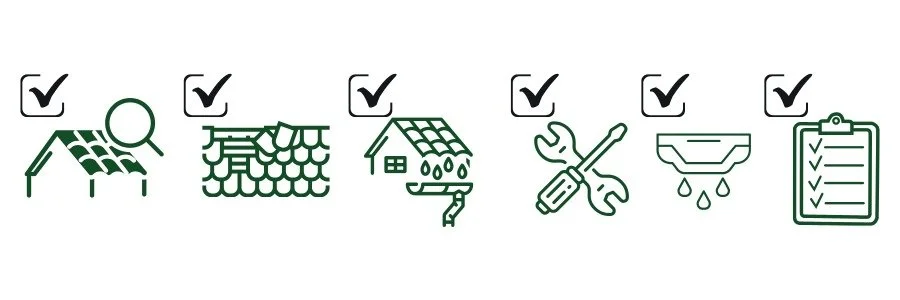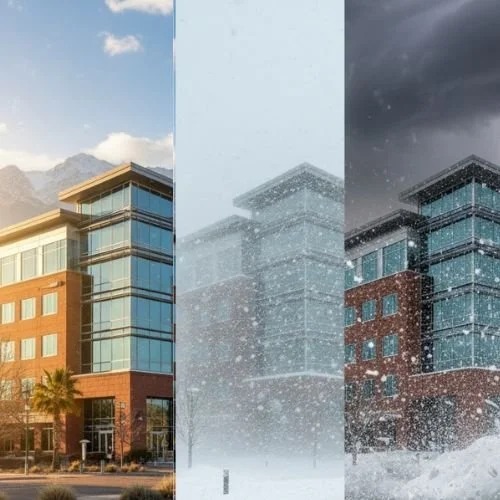How Regular Commercial Roof Maintenance Extends the Life of Your Colorado Property
Maintaining a commercial roof is more than a routine chore; it’s a long-term investment in protecting your property, ensuring safety, and reducing costly repairs. Colorado’s climate presents unique challenges for commercial roofs, from heavy snow and hail to intense UV exposure and seasonal temperature swings. Without proper care, even the highest-quality roof materials can deteriorate faster than expected.
Implementing a consistent roof maintenance program allows property managers and facility teams to extend the lifespan of their roofs, prevent leaks, and avoid expensive emergency repairs. To understand the broader strategies that keep commercial roofs safe and durable over time, explore our article about strategies to protect your commercial roofing.
Why Commercial Roof Maintenance is Essential
Regular commercial roof maintenance is crucial for several reasons. It ensures the integrity of the roof, prevents minor issues from escalating, and maximizes the return on your investment. Here are the main benefits:
Preventive vs Reactive Maintenance
Preventive maintenance focuses on scheduled inspections, minor repairs, and proactive care, while reactive maintenance only addresses issues after they occur. Proactive care can reduce repair costs significantly, minimize disruptions to your business, and improve safety. Roof preventative maintenance not only keeps your roof functional but also protects the building’s occupants and assets.
Extending Roof Lifespan
Most commercial roofs have a lifespan of 15 to 30 years, depending on the materials and climate. Regular inspections and preventive care can extend this lifespan by several years. Simple practices like clearing debris, inspecting membranes, and repairing minor leaks help maintain structural integrity and avoid premature deterioration. Knowing the lifespan of a commercial roof allows property owners to plan maintenance schedules effectively and budget for eventual replacements.
Cost Savings and Safety Benefits
A well-maintained roof reduces the likelihood of leaks, mold growth, and water damage. It also prevents small problems from turning into large-scale repairs. Preventive roof maintenance can save thousands in emergency repair costs and protect your business from liability issues related to roof failures. Roof leak prevention should be a top priority in any commercial maintenance program, particularly in regions with heavy snow and rainfall like Colorado.
Key Components of a Commercial Roof Maintenance Program
A successful maintenance program consists of several key components that work together to keep your roof in optimal condition.
Scheduled Inspections
Routine inspections are the cornerstone of any maintenance plan. Monthly, quarterly, and annual inspections help identify early signs of wear, tear, and damage. During inspections, look for:
Cracks or blisters in roof membranes
Pooled water on flat roofs
Damaged flashing around vents, chimneys, or skylights
Loose or missing fasteners
Signs of mold or mildew
Regular commercial roof inspections ensure that problems are addressed before they escalate.
Preventive Repairs
Small repairs done promptly can prevent major issues later. This includes patching leaks, sealing cracks, replacing damaged shingles or membranes, and repairing flashing. Preventive repairs also include applying protective roof coatings to prolong the roof’s life. Commercial roof preventative maintenance is not just about patching leaks; it’s about preserving the roof system’s overall health.
Cleaning and Drainage Maintenance
Debris, leaves, and dirt can accumulate on the roof, clogging drains and gutters. Proper cleaning and drainage maintenance prevent water from pooling, which is one of the leading causes of leaks and structural damage. For flat roofs, ensuring drains are clear and functioning is especially critical. Flat roof maintenance requires attention to membrane integrity, water flow, and seasonal snow removal.
Documentation and Reporting
Keeping detailed records of inspections, maintenance tasks, and repairs ensures continuity and supports warranty compliance. Documentation helps property managers track trends, identify recurring issues, and plan future maintenance efficiently.
Flat Roof Maintenance Considerations
Flat roofs are common in commercial buildings but require unique attention. Water does not run off as quickly as with pitched roofs, which increases the risk of ponding and leaks. Here are some key considerations for flat roof maintenance:
Inspect drains and scuppers to prevent clogs
Ensure roof membranes are intact and free of punctures
Remove snow promptly in winter to avoid excess weight
Monitor for signs of blistering, cracking, or UV damage
Flat roof maintenance is vital to prolonging the roof’s life and preventing unexpected leaks. Using preventive roof maintenance techniques can significantly reduce repair costs and extend service life.
Creating a Roof Maintenance Checklist
A comprehensive roof maintenance checklist helps ensure that all aspects of your roof are regularly inspected and maintained. A well-structured checklist should include:
Visual inspection of the entire roof surface
Checking all seams, joints, and flashing
Inspecting gutters and drains
Assessing rooftop equipment (HVAC units, antennas, vents)
Checking for water pooling or ponding
Documenting repairs and maintenance activities
A checklist not only provides structure but also helps teams track progress and prioritize repairs. Property managers can adapt the checklist to the specific roof type and environmental conditions, ensuring that maintenance is thorough and consistent.
Cost of Commercial Roof Maintenance
The cost of regular roof maintenance is far lower than emergency repairs or premature roof replacement. On average, commercial roof maintenance costs can range from $0.15 to $0.50 per square foot annually, depending on the size of the building and roof complexity. Preventive maintenance reduces the likelihood of costly repairs caused by leaks, structural damage, or storm-related incidents.
Investing in regular maintenance is also a smart financial strategy. A roof that is properly cared for can exceed its expected lifespan, delaying the need for expensive replacements. Understanding roof maintenance costs helps property owners plan budgets effectively while protecting their investment.
Selecting a Commercial Roof Maintenance Company
Choosing the right maintenance partner is crucial. Look for a trusted roofing company with experience in commercial properties, proper licensing, and strong references. A professional company provides:
Scheduled inspections and reports
Preventive and emergency repairs
Expertise in various roof types, including flat and metal roofs
Compliance with safety standards
Partnering with a trusted roofing company ensures that your maintenance program is efficient, effective, and aligned with best practices. A reliable maintenance company not only extends the life of your roof but also minimizes disruption to your daily operations.
If you are ready to start a maintenance program or need professional guidance, you can contact Strong Contractors for expert assistance.
view our recent roofing project
Conclusion
Commercial roof maintenance is not optional it is essential for protecting your property, reducing long-term costs, and ensuring safety. From regular inspections and preventive repairs to cleaning, documentation, and working with a trusted roofing company, each step plays a role in extending the life of your roof.
Investing in a well-structured maintenance program ensures that your building remains secure, functional, and protected against Colorado’s harsh climate.
Frequently Asked Questions
-
Commercial roofs should be inspected at least twice a year, ideally in the spring and fall. Additional inspections after major storms or extreme weather events are also recommended to identify and repair any damage promptly.
-
Yes. Preventive maintenance, including regular inspections, cleaning, and minor repairs, can extend the lifespan of a roof by several years. It reduces the risk of leaks, structural damage, and costly emergency repairs.
-
The cost typically ranges from $0.15 to $0.50 per square foot per year, depending on the roof size, type, and complexity. Investing in maintenance is generally much cheaper than reactive repairs or early roof replacement.






